 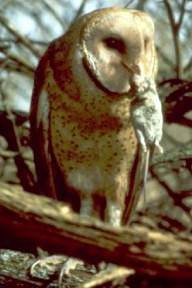 The Barn owl can often be found living in old buildings like barns, church steeples or abandoned houses. It lives just about everywhere in the world. The Barn owl’s voice is unusual ... it makes sounds that include screams, screeches, whistles, growls and hisses. Like most owls, the Barn owl is nocturnal, hunting at night. Its prey include mice, rats, voles, shrews and occasionally rabbits, gophers and small birds.
The Barn owl can often be found living in old buildings like barns, church steeples or abandoned houses. It lives just about everywhere in the world. The Barn owl’s voice is unusual ... it makes sounds that include screams, screeches, whistles, growls and hisses. Like most owls, the Barn owl is nocturnal, hunting at night. Its prey include mice, rats, voles, shrews and occasionally rabbits, gophers and small birds.Farmers like having these owls around, as they help to control the rodent population. Barn owls attack their prey by flying low over the ground; they grab prey with their feet, bite through the back of its neck, and often swallow it whole. Barn owls weigh about half a kilogram and have a wingspan of over a metre. They have a heart shaped face, and no ear tufts like some other owls have. Their large bright eyes help them to see at night. Barn owls can also locate their prey by sound. They have excellent hearing, and can pick up sounds of small animals under vegetation and snow. Their soft feathers help to muffle the sound of their flight; a hunting barn owl is almost completely silent. Barn owls don't build nests; they roost in whatever out-of-the-way location they can find. The babies hatch from eggs about one month after they are laid. Both parents care for the babies for another two months, hunting up to three kilometres from the nest. 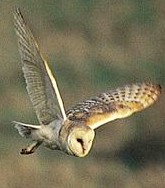 Young Barn owls will eat about a dozen mice every night; adult Barn owls kill and eat the equivalent of one large rat or gopher per night. Barn owls consume twice as much food for their body size as other owls. Young Barn owls will eat about a dozen mice every night; adult Barn owls kill and eat the equivalent of one large rat or gopher per night. Barn owls consume twice as much food for their body size as other owls.
You can often find owl pellets around Barn owl roosts. Pellets are balls of fur and small bones from the prey the owl has eaten, which the owl can't digest; it coughs these up after each meal. You can identify the kinds of small creatures it has eaten by examining these pellets; that's what we're going to show you. Examining Owl Pellets My school at one point purchased Owl Pellet kits; you can order them from Merlan Scientific in Toronto. A class set of 15 is $98.00. (You can also order them individually or in smaller quantities). The pellets have been sterilized and are chemical-free. Like most birds, owls can't chew their food; they often swallow their prey whole. But they're different from most birds because they don't have a crop (the organ used to store food after it has been swallowed so that it can be digested later). In owls, food goes right from the mouth to the gizzard ... a sort of stomach that contains digestive fluids and sand that dissolve and grind up food. 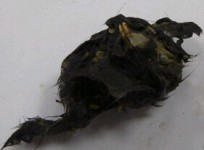 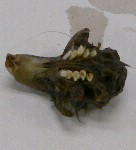 But some of the parts of the animals eaten by an owl, like beaks, claws, fur and bones, can't be digested. So the owl spits them up! (This is called regurgitation). This is what makes an owl pellet.
You can find out what an owl eats by examining these pellets. Most of the indigestible material is still whole, and often a skull can be found, making identification of the animal that was eaten easy.
But some of the parts of the animals eaten by an owl, like beaks, claws, fur and bones, can't be digested. So the owl spits them up! (This is called regurgitation). This is what makes an owl pellet.
You can find out what an owl eats by examining these pellets. Most of the indigestible material is still whole, and often a skull can be found, making identification of the animal that was eaten easy.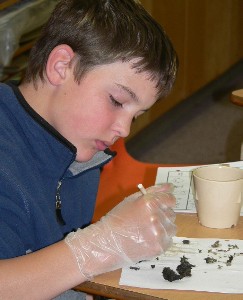  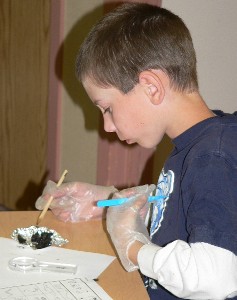 Our Grade 3/4 class examined some Barn owl pellets. The pellets were soaked in water first to make them easier to pick apart. (This also made them smell rather unpleasant ... but no-one seemed to notice!) Students wore gloves, and used simple tools to separate out the various bones, feathers, teeth and skulls. Everyone was amazed to see the skeletal parts of various tiny creatures appear. We identified feathers from small birds, and bones and skulls from mice and shrews.  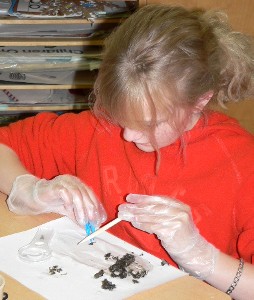 Includes a free identification chart |